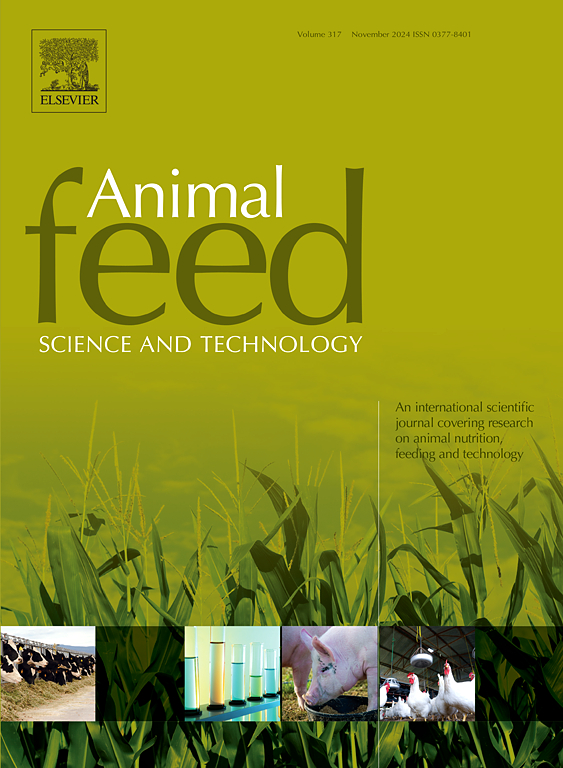饲料赖氨酸缺乏部分通过生长中的草鱼Janus激酶(JAKs)/信号转导和转录激活因子(STATs)信号通路引起肠道免疫功能障碍
IF 2.5
2区 农林科学
Q1 AGRICULTURE, DAIRY & ANIMAL SCIENCE
引用次数: 0
摘要
赖氨酸是水生动物体内的限制性氨基酸,主要来源于饲料中的蛋白质,包括鱼粉、菜籽粕、豆粕和酪蛋白。肠道免疫功能对维持生物体,特别是鱼类的健康和正常生长至关重要。本试验旨在进一步探讨饲粮赖氨酸缺乏对草鱼(Ctenopharyngodon idella)感染嗜水气单胞菌后肠道疾病抵抗、免疫反应及信号传导机制的潜在影响。试验共选取初始体重为164.85 ± 0.79 g的540尾鱼,分为6个处理,每处理3个重复,每个重复30尾鱼。将30条鱼放入渔网(140 cm × 140 cm × 140 cm)中。饲喂赖氨酸水平分别为5.6、8.5、11.6、14.4、17.5和20.7 g/kg的等氮饲料,为期60 d,然后进行为期6 d的激射试验。饲喂试验期间,每天投喂4次相应饲料。试验结束时,根据平均体重,从每个处理组中选取24尾鱼(每个重复8尾)取样。研究表明,饲粮赖氨酸缺乏(5.6 g/kg)导致:(1)生长性能(体长、体况因子和摄食率)和肠道发育(肠长、肠重、肠长指数和肠体指数)显著(P <; 0.05)降低;(2)对致病性嗜水气单胞菌感染的抵抗力显著降低(P <; 0.05),肠炎发病率最高,肠道组织病理学改变显著;(3)通过改变各种免疫成分,包括抗菌肽、补体3 (C3)和免疫球蛋白M (IgM),显著降低肠道免疫应答(P <; 0.05);(4)显著(P <; 0.05)通过改变炎症相关细胞因子的表达谱加重肠道炎症,这些细胞因子与Janus Kinase (JAK)/signal transducer and activator of transcription (STAT)信号的调控有关。相比之下,肠道中白细胞介素(IL)-12p35、STAT2、STAT3a和STAT6的转录丰度不受饲料赖氨酸的调节。此外,根据各种免疫和生理参数,我们估计育成期草鱼日粮赖氨酸需求水平在13.93 ~ 14.51 g/kg之间。本文章由计算机程序翻译,如有差异,请以英文原文为准。
Dietary lysine deficiency causes intestinal immune dysfunction partially via Janus kinases (JAKs)/signal transducers and activators of transcription (STATs) signalling pathways of on-growing grass carp (Ctenopharyngodon idella)
Lysine is the limiting amino acid in aquatic animals, primarily derived from protein sources in feed, including fish meal, rapeseed meal, soybean meal, and casein. The intestinal immune function is crucial for maintaining the health and normal growth of organisms, particularly in fish. Further investigation was conducted to explore the potential impact of dietary lysine deficiency on intestinal disease resistance, immune response and signaling mechanisms in grass carp (Ctenopharyngodon idella) infected with Aeromonas hydrophila. A total of 540 fish (initial body weight: 164.85 ± 0.79 g) were allotted to 1 of 6 treatments with 3 replicates and 30 fish per replicate. The 30 fish were placed in a fishing net (140 cm × 140 cm × 140 cm). Fish were fed 6 isonitrogenous diets with varying lysine levels (5.6, 8.5, 11.6, 14.4, 17.5, and 20.7 g/kg diet) over a period of 60 days, followed by a 6-day challenge experiment. During the feeding trial, the fish were fed their corresponding diets 4 times daily. At the conclusion of the experiment, 24 fish from each treatment group (8 fish from each replicate) were selected for sampling based on their average weight. The research manifested that dietary lysine deficiency (5.6 g/kg diet) resulted in: (1) significantly (P < 0.05) decreased the growth performance (body length, body condition factor and feeding rate) and intestinal development (intestinal length, intestinal weight, intestinal length index and intestinal somatic index); (2) markedly (P < 0.05) decreased the resistance to pathogenic Aeromonas hydrophila infection, as evidenced by the highest rates of enteritis morbidity and notable histopathological alterations in the intestine; (3) significantly (P < 0.05) reduced the intestinal immune response through alterations in various immune components, including antibacterial peptides, complement 3 (C3) and immunoglobulin M (IgM); and (4) dramatically (P < 0.05) aggravated the intestinal inflammation through alterations in the expression profiles of inflammatory-related cytokines, which are linked to the regulation of Janus Kinase (JAK)/signal transducer and activator of transcription (STAT) signaling. In contrast, the intestinal transcriptional abundances of interleukin (IL)-12p35, STAT2, STAT3a and STAT6 were not regulated by dietary lysine. Furthermore, we estimated that the dietary lysine requirement levels for on-growing grass carp are between 13.93 and 14.51 g/kg of diet, based on various immune and physiological parameters.
求助全文
通过发布文献求助,成功后即可免费获取论文全文。
去求助
来源期刊

Animal Feed Science and Technology
农林科学-奶制品与动物科学
CiteScore
6.00
自引率
6.20%
发文量
266
审稿时长
3 months
期刊介绍:
Animal Feed Science and Technology is a unique journal publishing scientific papers of international interest focusing on animal feeds and their feeding.
Papers describing research on feed for ruminants and non-ruminants, including poultry, horses, companion animals and aquatic animals, are welcome.
The journal covers the following areas:
Nutritive value of feeds (e.g., assessment, improvement)
Methods of conserving and processing feeds that affect their nutritional value
Agronomic and climatic factors influencing the nutritive value of feeds
Utilization of feeds and the improvement of such
Metabolic, production, reproduction and health responses, as well as potential environmental impacts, of diet inputs and feed technologies (e.g., feeds, feed additives, feed components, mycotoxins)
Mathematical models relating directly to animal-feed interactions
Analytical and experimental methods for feed evaluation
Environmental impacts of feed technologies in animal production.
 求助内容:
求助内容: 应助结果提醒方式:
应助结果提醒方式:


